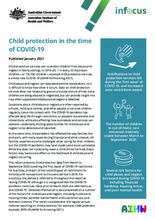Child protection services aim to protect children from abuse and neglect in family settings. In 2019–20, 1 in every 33 Australian children—or 174,700 children—received child protection services, a similar rate to 2018–19 (AIHW forthcoming 2021).
Child abuse and neglect can take place behind closed doors, so it is difficult to know how often it occurs. Data on child protection services does not necessarily give an accurate picture of how many children are being abused or neglected, but can provide insight into how often suspected child abuse and neglect is detected.
Suspicions about child abuse or neglect are often reported by schools, child care centres, and other people or services children regularly come into contact with. The COVID-19 pandemic has affected daily life through restrictions on people’s movements and interactions, while also affecting how businesses and services can operate—potentially limiting opportunities for child abuse and neglect to be detected and reported.
At the same time, the pandemic has affected the way families live and work, with many experiencing financial and other stresses. All families experience some challenges when caring for their children, but the COVID-19 pandemic may have made some more vulnerable. While this does not necessarily mean a child will be harmed, these factors may have some effect on the likelihood of child abuse and neglect occurring.
This report presents child protection data from March to September 2020 (covering the ‘first wave’ of COVID-19 restrictions for Australia, and part of the ‘second wave’ of restrictions for Victoria) with comparisons to the same period in 2019. For simplicity, this period is referred to throughout the report as ‘during COVID-19’ although it is recognised that the COVID-19 pandemic continues. Data prior to March 2020 are referred to as ‘pre-COVID-19’. Selected information is also presented on a number of risk factors for child abuse and neglect, including income and housing stress, parental mental health and substance use, and domestic violence. This report complements the regular annual national reporting on child protection, for example, Child protection Australia 2019–20 (AIHW forthcoming 2021).

